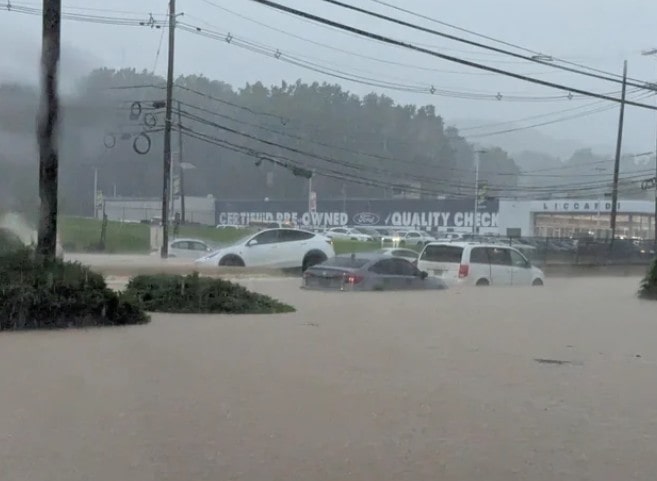New Jersey Flooding: State of Emergency Declared as Torrential Rains Batter Northeast
New Jersey flooding triggered a state of emergency on Monday night as relentless storms lashed the Northeast, turning roads into rivers and grinding air travel to a halt.
Across the Hudson, New York City wasn’t spared either. All five boroughs were placed under a flood warning as flash floods ripped through the area. Viral clips flooded social media — subway stairs became waterfalls, and platforms were submerged. Westchester County saw cars stranded mid-road, completely swamped in rising waters.
“If you live in a basement apartment or low-lying area, be ready to move to higher ground,” warned NYC 311 in a post on X, urging residents to act fast as rainstorms intensified through the afternoon.
By evening, things worsened. New Jersey Governor Phil Murphy declared a state of emergency, citing “high levels of rainfall” and dangerous flooding throughout parts of the state.
“Please stay indoors and avoid unnecessary travel. Stay safe, New Jersey,” Murphy posted on X.
Flight chaos soon followed. Ground stops were issued at major East Coast airports — JFK, LaGuardia, and Newark Liberty among the hardest hit.
Delays ballooned, with many passengers stuck for hours. Some planes were forced to circle in the skies, waiting for clearance to land. Others diverted entirely.
One frustrated passenger wrote, “We have been circling just outside New York for last 90 minutes… Pilot just told us that [we] have 1 hour of fuel left… before we land somewhere else.”
Another traveller stranded at Newark airport fumed, “I’ve been sitting at Newark airport for over 4 hours now.”
By 8:30 p.m., some of the FAA-imposed stops were lifted, but delays stretched from 45 minutes to over three hours.
The National Weather Service had predicted heavy rainfall — one to two inches in places like Queens — earlier in the day. By nightfall, the system had shifted eastward and weakened slightly. But flooding continued in parts of New Jersey, including Newark, where waters rose quickly.
Their 10 p.m. update said, “The heaviest rainfall has shifted east and weakened… this rain is expected to continue to move east and lessen in intensity through the night.”
Even as the rain began to taper, another threat loomed. Scorching heat. New York City officials warned that Tuesday could bring “hot and humid conditions” with temperatures expected to “approach or exceed” 100 degrees Fahrenheit, posing further challenges to already strained services.
The deluge was yet another stark reminder of the region’s increasing vulnerability to extreme weather. As cleanup begins, both states remain on high alert — watching the skies for what may come next.






